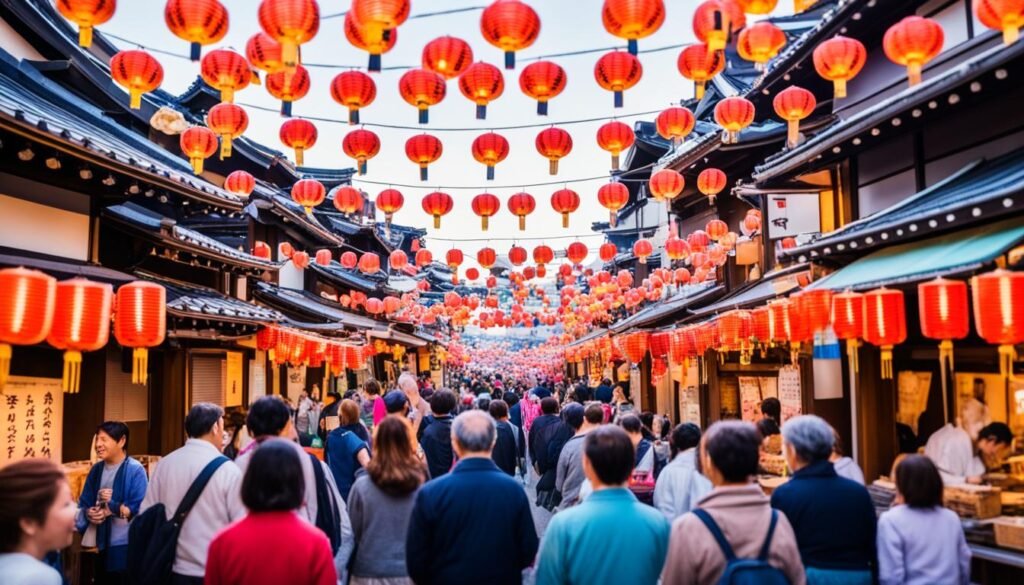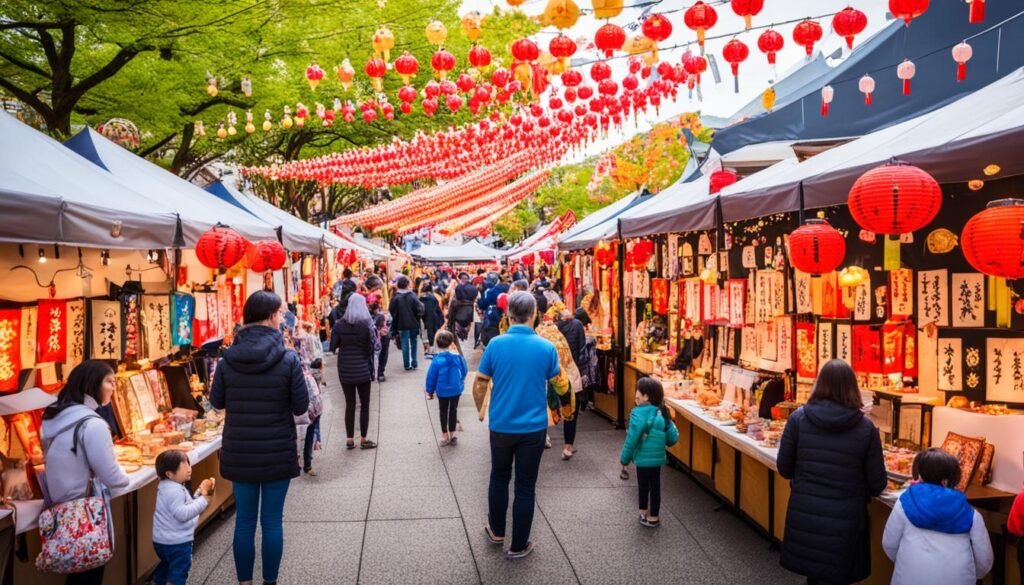Table of Contents
In the warm summer months, Japan comes alive with colorful festivals. These run from June through September. You can enjoy both traditional and modern celebrations.
This season, Japan is a wonderful place for families. It’s filled with events that show the heart of Japanese culture. The festivals also welcome you with open arms and offer fun activities for everyone.
So, get ready to explore Japan’s summer festivals. These events are all about bringing families together and sharing cultural traditions. You’ll find lots of kid-friendly activities waiting for you.
Capturing the Essence of Japanese Summer Festivals
Japanese summer festivals are called matsuri. They are rich in tradition. Celebrations honor a shrine’s deity or mark a special event. They may even celebrate the changing season. These events are lively, with processions of ornate floats and shrines. These floats and shrines represent the kami – or deity – with lively music from drums and flutes.
Vibrant Celebrations Honoring Traditions
Each Japanese summer festival has its own special vibe. Some are calm, while others burst with color and energy. Yet, all of them share singing, dancing, and happy participation from the crowd. This makes the experience deeply cultural for everyone involved.
Immersive Cultural Experiences
Visiting a Japanese summer festival lets you dive into the country’s culture. You get to see detailed traditions, colorful performances, and join in the community spirit. This helps you understand and love the meaning behind the celebrations.
Festivals as a Window into Local Communities
These summer festivals are like a peek into local life and heritage. They show a community’s unique customs and spirit. Being part of one can give you memories for a lifetime and a strong link to Japan’s culture.
Gion Matsuri: Kyoto’s Grand Celebration
The Gion Matsuri in Kyoto is among Japan’s most renowned festivals. It’s held throughout July, taking over downtown Kyoto. This celebration enchants both residents and visitors, offering grand processions and lively events.
History and Significance of the Festival
In 869, Emperor Seiwa organized a festival to honor the Gods. It was a prayer to protect the city from the plague. Since then, this festival has grown into a symbol of Japan’s deep cultural roots and faith.
Highlights: Yamaboko Junko and Yoiyama
The Yamaboko Junko is the festival’s main parade. It’s so magnificent that UNESCO has recognized it. The parade boasts beautiful floats, with performances and designs that leave all who see it in awe.
Before the parades, Yoiyama takes place. It’s a series of lively street parties that feature food vendors and people wearing traditional yukata robes. This makes the festivities more engaging for everyone.
 What are some unique family experiences to enjoy in New Zealand?
What are some unique family experiences to enjoy in New Zealand?
Tenjin Matsuri: Osaka’s Riverside Revelry
Osaka’s Tenjin Matsuri is one of Japan’s top three festivals. It takes place at the end of July. This festival honors Sugawara no Michizane, the God of Learning, and the main deity of Osaka Tenman-gu Shrine.
Rituals and Processions
On July 24th, people pray at the shrine for Osaka’s well-being. They cast these prayers along the Okawa River. The next day, the festival bursts with life. Traditional floats and portable shrines fill the streets. Dancers, lion dancers, umbrella dancers, and drummers join in.
The most important shrine is placed on a boat on the Okawa River. This river is lined with 100 boats decorated for the occasion, glowing in the dark.
Fireworks Extravaganza over the Okawa River
The festival ends with fireworks over the Okawa River. This show makes it even more magical. It’s the perfect way to close this grand celebration in Osaka.
Sumidagawa Fireworks Festival: Tokyo’s Illuminated Spectacle
The Sumidagawa Fireworks Festival lights up Tokyo’s sky on the last weekend of July. It began in the 18th century after Tokugawa Yoshimune’s wish to end famine and scare off evil. Since then, it’s been a grand event along the Sumida River with the Tokyo SkyTree shining in the backdrop.
To get a good view, it’s smart to come early because the festival is very popular. There’s also a paid seating option to make things easier. For anyone in Tokyo during the summer, this festival is a highlight. It shows off stunning fireworks that light up the city.
Shonan Hiratsuka Tanabata Festival: Star-Studded Celebration
The Shonan Hiratsuka Tanabata Festival is one of the top three festivals for the Tanabata holiday in Kanto. Tanabata is the “Japanese star festival”. It marks the day two deities, separated for most of the year, can meet.
Tanabata: The Japanese Star Festival
This festival lasts for three days, starting on a Friday in early July. The main shopping street in Hiratsuka City is decorated with over 500 pieces, some as tall as 10 meters. These ornaments are a big part of celebrating the Tanabata festival, mixing both Japanese and Chinese traditions.
The Main Event
On the main street, there are also food stalls and games like water yoyo fishing for visitors to try. The Tanabata Odori Parade is captivating. In the evening, the decorations light up the area with a starry night feel.
Tanabata Odori: Traditional Dances
The Tanabata Odori Parade showcases traditional dances down the street. This makes the festival lively and fun. It’s a special Japanese star festival everyone should experience, to see and join the beautiful festival decorations and parades at the Shonan Hiratsuka Tanabata Festival.
What family-friendly festivals are happening in Japan this summer?
The Obon period, around mid-August, sees many dance festivals in Japan. Awa Odori in Tokushima stands out. It’s a famous dance festival where roads are closed for dancers.
 What water activities can I do in Hawaii?
What water activities can I do in Hawaii?
Groups of performers called “Ren” do specific dances with live music. This celebration includes a dance called the “Fool’s Dance”, which has been part of the festival since the 10th century. Anyone can join in, from beginners to experts.
Awa Odori: Tokushima’s Lively Dance Festival
In Aomori City, the Nebuta Matsuri festival is a big hit. It involves huge lantern floats that stand up to 9 meters tall and 5 meters wide. These floats are part of a grand procession, along with taiko drums, music, and dancers.
This festival has nightly parades in the city except the last day, when it starts in the afternoon. The parade is followed by a fantastic fireworks display to end the festivity.
Nebuta Matsuri: Giant Lantern Floats in Aomori

Preparing for a Japanese Summer Festival
When you go to a Japanese summer festival, dress right. Many choose to wear a yukata, a lightweight cotton kimono. This choice helps you dive into the festival’s traditional feeling. Wearing traditional clothes makes the festival experience more fun and real.
Savoring Traditional Festival Delicacies
There’s more to the festival than just looks and shows. You also get to try lots of yummy food like yakisoba (fried noodles), takoyaki (octopus treats), and others. Eating this food is a big part of feeling like you’re at a real Japanese summer festival.
Family-Friendly Activities and Experiences
Japanese summer festivals are perfect for families with kids. They are filled with fun activities. You can join in the exciting parades and dances. Some events need you to wear special outfits, like the haneto dancing clothes at the Nebuta Matsuri in Aomori.
Joining the Parades and Dances
At these festivals, you can march in the parades and dances. This lets families dive into the cultural celebrations. You’ll find events like the rhythmic Awa Odori in Tokushima and the big Yamaboko Junko in Kyoto’s Gion Matsuri. They’re great for making long-lasting memories for both kids and grown-ups.
Games and Entertainment for Children
There’s more than just parades and shows. Japanese summer festivals also have loads of fun for kids. Families can try water yoyo fishing and play fun games. These activities are designed to keep children happy and entertained. They add to the fun and memorable experience of these cultural celebrations.

Planning Your Summer Festival Adventure
When heading to Japan’s summer festivals, plan ahead. You should book your place to stay early, especially for big festivals like Gion Matsuri in Kyoto. They get very crowded. For top spots like the Sumidagawa Fireworks Festival, arrive early to grab a good view.
It’s also smart to know the festival schedule and main events. This helps ensure you catch the key processions, parades, and more. With a bit of research, you can dive fully into Japan’s summer festival season.
 What outdoor adventures await in the Patagonia region of Argentina?
What outdoor adventures await in the Patagonia region of Argentina?
To enjoy Japanese summer festivals to the max, start by planning your adventure. Focus on where to stay, the best views, and understanding the schedule. Doing this makes for an unforgettable festival experience.



